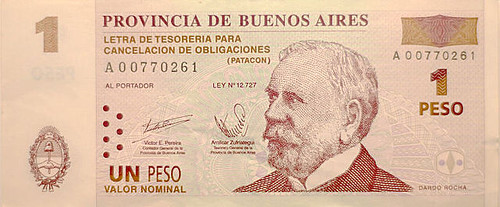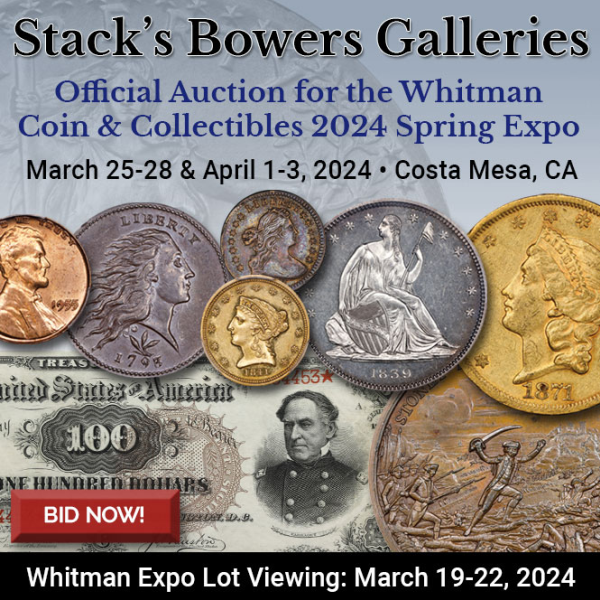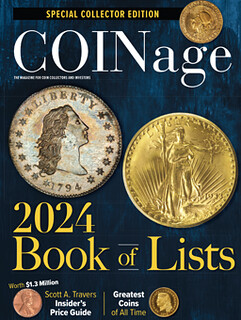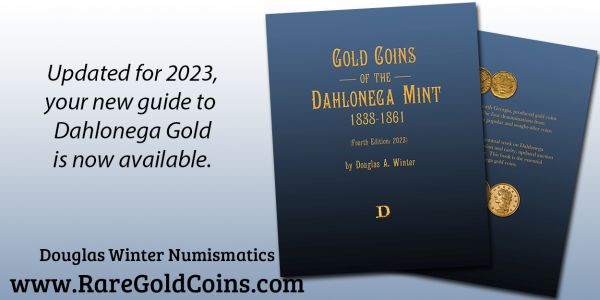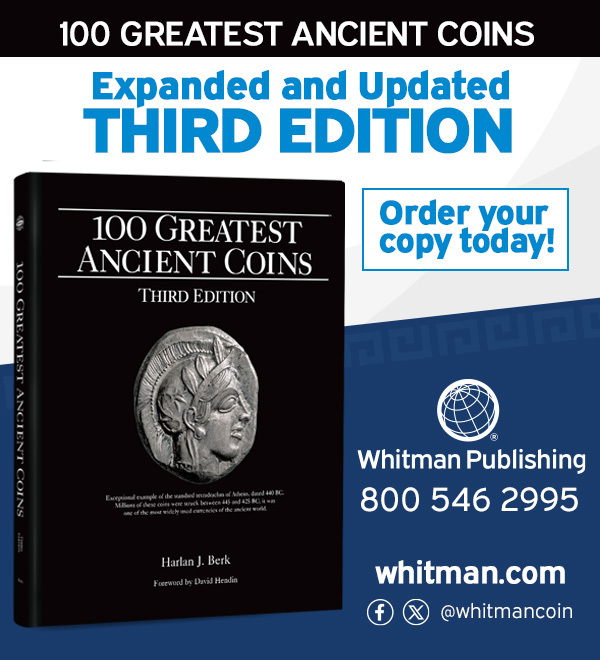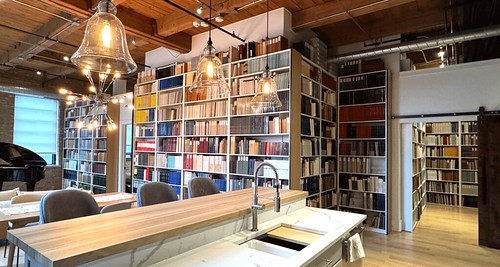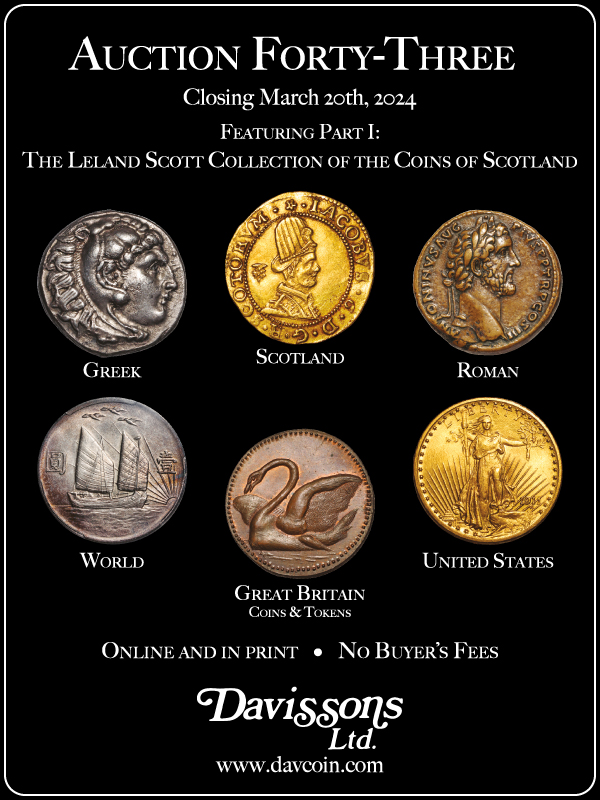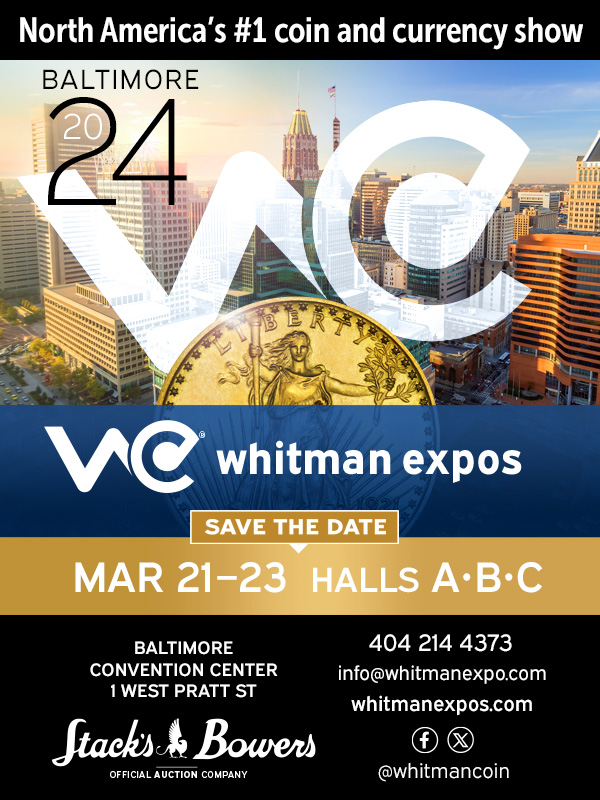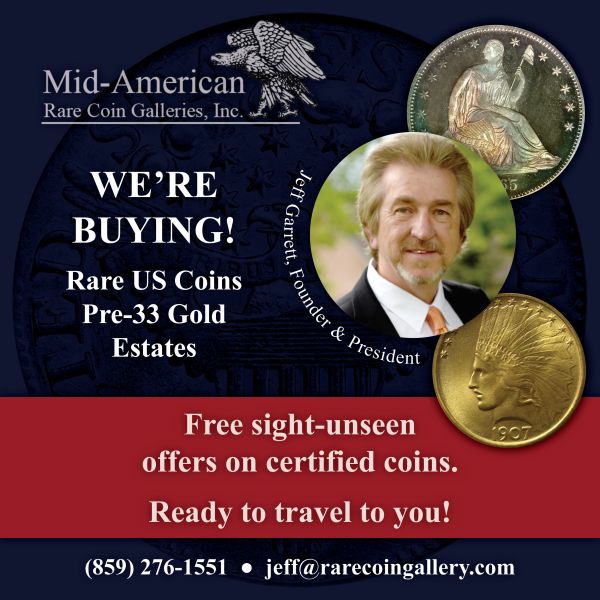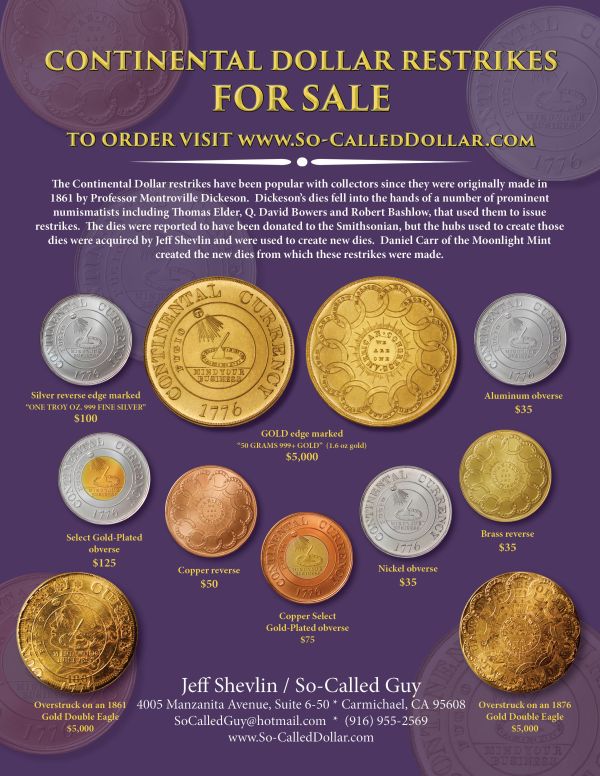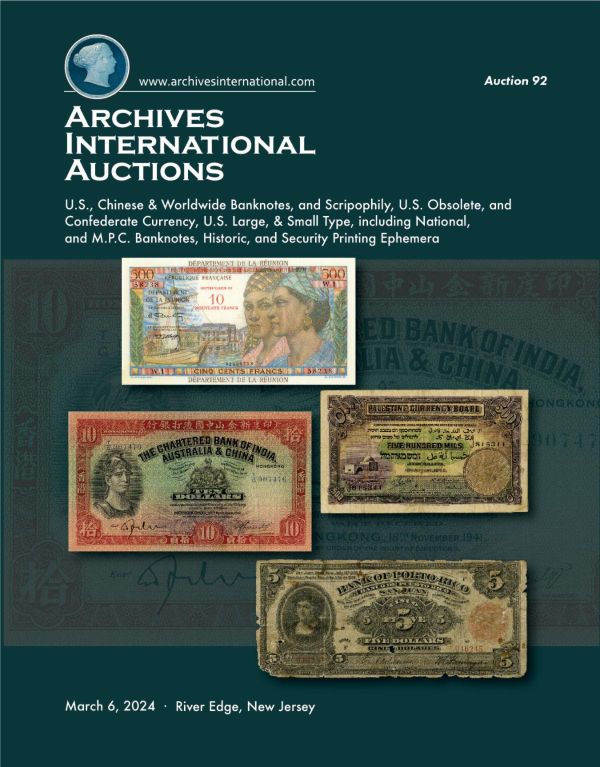
Visit our NBS Sponsors




About UsThe Numismatic Bibliomania Society is a non-profit association devoted to the study and enjoyment of numismatic literature. For more information please see our web site at coinbooks.org SubscriptionsThose wishing to become new E-Sylum subscribers (or wishing to Unsubscribe) can go to the following web page link MembershipThere is a membership application available on the web site Membership Application To join, print the application and return it with your check to the address printed on the application. Print/Digital membership is $40 to addresses in the U.S., and $60 elsewhere. A digital-only membership is available for $25. For those without web access, write to: Jeff Dickerson, Treasurer AsylumFor Asylum mailing address changes and other membership questions, contact Jeff at this email address: treasurer@coinbooks.org SubmissionsTo submit items for publication in The E-Sylum, write to the Editor at this address: whomren@gmail.com BUY THE BOOK BEFORE THE COINSale CalendarWatch here for updates! |
- WAYNE'S WORDS: THE E-SYLUM MARCH 3, 2024
- NEW BOOK: COINAGE 2024 BOOK OF LISTS
- BANKNOTE BOOK TIBET CHAPTER PUBLISHED
- JACOB ROTHSCHILD (1936-2024)
- 1862 JOSEPH J. MICKLEY LETTER
- NEWMAN PORTAL DIGITIZATION WORKFLOWS
- VIDEO: ANS CLAPP COLLECTION LARGE CENTS
- S&S LIBRARY UPDATE
- MORE ON THE SPANISH-U.S. DOLLAR TRADE
- MORE ON WALTER JOHNSON'S DOLLAR THROW
- NOTES FROM E-SYLUM READERS: MARCH 3, 2024
- CLAIN-STEFANELLI'S NUMISMATICS - AN ANCIENT SCIENCE
- 1870S EMPEROR NORTON MARKET FORECASTS
- VOCABULARY TERM: PERSONAL MEDAL
- STANLEY THOMAS KIRBY (1940-2005)
- ANS 2023 HUNTINGTON AWARDEE: RUTH PLIEGO
- CENTRAL STATES INAUGURAL STATE SHOWCASE
- NUMISMAGRAM MEDAL SELECTIONS: MARCH 3, 2024
- 2024 MADISON COUNTY COIN CLUB MEDAL AVAILABLE
- STACKS OFFERS SLOVICK INDIAN PEACE MEDALS
- COINS OF THE HOUSE OF VALENTINIAN
- OXFORD POUND OFFERED
- 1723 SOUTH SEA COMPANY SHILLING
- KING CHARLES III 2024 MAUNDY COIN PLANS
- BINION 1934 $10,000 BILL OFFERED
- $100 BILL, AMERICA'S MOST ANNOYING CURRENCY
- SO WHO'S USING ALL THE CASH?
- THE BIRTH OF A (PSEUDO) CURRENCY
- LOOSE CHANGE: MARCH 3, 2024
- DELHI MAN SWALLOWS 39 COINS... AND MORE!
Content presented in The E-Sylum is not necessarily researched or independently fact-checked, and views expressed do not necessarily represent those of the Numismatic Bibliomania Society.
WAYNE'S WORDS: THE E-SYLUM MARCH 3, 2024
 Thank you for reading The E-Sylum. If you enjoy it, please send me the email addresses of friends you think may enjoy it as well and I'll send them a subscription. Contact me at whomren@gmail.com anytime regarding your subscription, or questions, comments or suggestions about our content.
Thank you for reading The E-Sylum. If you enjoy it, please send me the email addresses of friends you think may enjoy it as well and I'll send them a subscription. Contact me at whomren@gmail.com anytime regarding your subscription, or questions, comments or suggestions about our content.
This week we open with two new books, a billionaire obit, updates from the Newman Numismatic Portal, notes from readers, and more.
Other topics this week include Joseph Mickley, George Clapp, Walter Johnson, Elvira Clain-Steffanelli, Emperor Norton, Stan Kirby, Ruth Pleigo, the Central States Numismatic Society, fixed price and auction offerings, Indian Peace medals, the South Sea Company shilling, Maundy coins, Binion bills, and pseudo currency.
To learn more about Government of Tibet paper money, the S&S Library, the Roosevelt "Lucky Tillicum" coin, personal medals, Tri-State Coin Supply, the Peace of Nystadt medal, coins of Valentinian, America's most annoying currency, the Numismatica Domestica Club, Tesla's stolen head, and the Super Bowl LVIII Flip Coin, read on. Have a great week, everyone!
Wayne Homren
Editor, The E-Sylum
NEW BOOK: COINAGE 2024 BOOK OF LISTS
COINage has published a new book of lists. -Editor
COINage 2024 Book of Lists
$12.99
- Insider’s guide to U.S. coin values and mintage figures for the greatest rarities and all the popular coins, by Scott A. Travers, fully updated for 2024
- Comprehensive lists of coin dealers and auction companies plus coin clubs and organizations
- Best deals in trading coins and charting values
- Top six vintage commemorative coins
- David Hall’s greatest coins of all time
- Top five U.S. coins for fun and profit
- Exclusive: Photographic guide to grading silver American Eagle 1-oz bullion coins
- Coin collecting 101 with coin market directions and how to profit
- The case for gold and silver as currency and as an alternative investment
- Coin treasures buried at sea worth millions
BANKNOTE BOOK TIBET CHAPTER PUBLISHED
A new chapter of The Banknote Book has been published by Whitman-CDN. Written by Owen Linzmayer, the 8-page catalog covers 40 varieties of notes from the Government of Tibet from 1912 – 1950. -Editor
JACOB ROTHSCHILD (1936-2024)
Passing along a New York Times obituary, Jeff Zarit writes:
"This well-known family started as a coin dealer. In our industry, it is good to remember that."
 Jacob Rothschild, a wealthy financier, patron of the arts and philanthropist with close ties to Israel, who broke with his family’s fabled banking dynasty at a time of radical change in the world of high finance, has died. He was 87.
Jacob Rothschild, a wealthy financier, patron of the arts and philanthropist with close ties to Israel, who broke with his family’s fabled banking dynasty at a time of radical change in the world of high finance, has died. He was 87.
His death was announced on Monday by the Rothschild Foundation, a British charity of which he was the chairman. It did not specify when or where he died or give the cause of death.
Mr. Rothschild — more formally the fourth Baron Rothschild — was descended from Mayer Amschel Rothschild, a coin trader in the Jewish ghetto in Frankfurt, who sent four of his five sons to Vienna, London, Naples and Paris to seek their fortune in the late 18th and early 19th centuries.
1862 JOSEPH J. MICKLEY LETTER
Newman Numismatic Portal Project Coordinator Len Augsburger provided the following report about a rare letter from collector Joseph J. Mickley coming up for sale at Heritage. -Editor
Eric P. Newman Correspondence Files Showcase Auction Features 1862 Joseph J. Mickley Letter
Now open for bidding, Heritage Auctions is offering Selections from the Eric P. Newman Correspondence Files, a Showcase Auction which closes on March 25. Among the 97 lots is a two-page letter (lot #52083) from the Philadelphia numismatist Joseph J. Mickley, dated March 19, 1862, in which Mickley comments on coin prices.
The letter, signed by Mickley and addressed to Francis Lepère, notes in part “the price of American coins has gone up very high within several years past, owing to there being a great many Collectors and to our old coins being recoined, the old Copper Cents and Halves disappearing from circulation rapidly.” The reference to “halves” no doubt indicates half cents. As other authors have noted, the introduction of small cents in 1856 led many Americans to being examining their pocket change, especially large cents, and the overall “coin consciousness” of the American public grew steadily, especially on the east coast.
NEWMAN PORTAL DIGITIZATION WORKFLOWS
The latest addition to the Newman Numismatic Portal is a video about the digitization process. Project Coordinator Len Augsburger provided the following report. -Editor
Digitization Workflows Within Newman Portal
As noted in the February 18 E-Sylum, we’ve mounted a series of numismatic exhibits in Olin Library at Washington University in St. Louis for the Spring 2024 semester. Included in the exhibit is a video, created by Ian Lanius, Exhibitions Graphic Designer & Preparator, which illustrates digitization workflows utilized at the library to process varying media. We depict examples of multispectral imaging, high resolution scanning, digitization of transparencies, book scanning with facing cameras, and microfilm digitization. This video is displayed without sound, with subtitles walking viewers through the various workflows.
VIDEO: ANS CLAPP COLLECTION LARGE CENTS
The David Lisot Video Library on the Newman Numismatic Portal can be found at:
https://nnp.wustl.edu/library/multimediadetail/522852
We highlight one of his videos each week in The E-Sylum. Here's one from 2005 about the large cent collection George Clapp donated to the ANS. -Editor
S&S LIBRARY UPDATE
E-Sylum sponsor and NBS Board Member Shanna Schmidt published this library report in her Newsletter #211 yesterday. -Editor
The biggest achievement for me in the last few months was getting the BCD auction catalogs all on the shelves. It was no small feat and I feel compelled to thank a number of people who helped. The most important is my husband, Rainer, who helped to measure, design and coordinate construction of the bookshelves that house nearly 800 linear feet of catalogs. Next is Tyler Rossi, my dedicated and hardworking assistant, who unpacked hundreds of boxes, sometimes all on his own and put them up on the shelves in the correct order. Finally, my sons Jakob and Leo, who during their holiday break from studying, broke down those boxes and brought them out to the trash. It was a big affair but finally the library is starting to look like……well, a library!
MORE ON THE SPANISH-U.S. DOLLAR TRADE
Craig Sholley and Harry Salyards submitted these additional notes on the fineness of the silver in early U.S. coinage and the exchange of U.S. silver dollars for Spanish dollars. -Editor
More On The Spanish Dollar-U.S. Dollar Trade
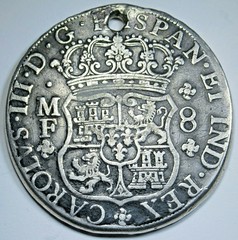 First, we wish to thank R.W. Julian for posting the 1797 letter from Secretary of the Treasury,
Oliver Wolcott, to the president and directors of the Bank of the United States, directing the
bank to send whatever gold or silver foreign coins they have to the mint for recoining, except
“Spanish dollars & parts of such dollars.”
First, we wish to thank R.W. Julian for posting the 1797 letter from Secretary of the Treasury,
Oliver Wolcott, to the president and directors of the Bank of the United States, directing the
bank to send whatever gold or silver foreign coins they have to the mint for recoining, except
“Spanish dollars & parts of such dollars.”
Of particular interest to the subject at hand, is Wolcott’s specific mention of the “mint act” of Feb. 9, 1793. That act made certain foreign coins legal tender, including Spanish dollars and their cut parts. However, the act also clearly states that in order to be legal tender, the dollars must weigh at least 415 grains (with cut parts in proportion).
MORE ON WALTER JOHNSON'S DOLLAR THROW
Readers have come up with more thoughts and reports relating to Walter Johnson's reenactment of the old George Washington story about throwing a silver dollar across the Rappahannock River. -Editor
Brian Healy of Walnut Creek, California writes:
"February 25 2024 E-Sylum had a short article about "Walter Johnson's Silver Dollar Throw" which mentioned a "Roosevelt Dollar".
"Could the coin have been one of Franklin Roosevelt's "Lucky Tillicum" election tokens? The E-Sylum issue of October 17, 2021 had an article about the "Lucky Tillicum"."
Seems very possible. Brian kindly included this image and description of the piece. Thanks. -Editor
Franklin D. Roosevelt "Lucky Tillicum" Coin
White metal, 27 mm, 8.28 gm
Obverse:
Franklin D. Roosevelt facing left
LUCKY TILLICUM / REBUILD WITH ROOSEVELT
Reverse:
Map of the United States with sunrise behind it.
PROSPERITY / 1933 / FOLLOW THE ROOSEVELT TRAIL
Julia Casey looked in newspapers and discovered two competing claims to the ownership of the piece Johnson threw. -Editor
NOTES FROM E-SYLUM READERS: MARCH 3, 2024
More on New Orleans Mint Gold
Rich Kelly and Nancy Oliver write:
"In the February 18, 2024 issue you presented an article from Tom Hoke on "Mislabeled History - a Billion Dollar Mistake" and in addition there was a discussion of the buried Confederate gold mystery. You added that you would be interested in anything further - well, we might have something.
In our June 2012 column for The Numismatist, we wrote of such an event, used material from Tom Hoke's book, and some from the Philadelphia Inquirer, other sources and put it together. The title of the column was "Stolen Gold", and it was in depth on the mystery."
From the article:
The Civil War story of murder, a Confederate deserter and a stash of coins raises some interesting questions.
IN APRIL 1863, the American Civil War was raging across a large portion of our beleaguered nation. At the time, Union forces were trying to take Brashear City, Louisiana, one of the many towns in contention. An interesting incident occurred there involving a Confederate soldier who had abandoned his unit and was arrested by Union troops as he crossed enemy lines. This deserter was discovered to have quite a hoard of U.S. coins, and the story he told to explain it is rather intriguing.
Thank you. The Numismatist piece references a March 28, 1863 Philadelphia Inquirer article with the soldier's buried gold story, but we were unable to relocate it. The date may be incorrect, or the article was republished in another paper. Rich and Nancy's library and files were lost in a fire. Interesting incident, which may or may not be connected to the New Orleans Mint. Here's how Rich and Nancy closed the article. -Editor
Whether any further search or inquiry was made concerning the buried gold and the Confederate soldier's unearthing of the double eagles remains a mystery. If the two incidents are somehow entwined, the Confederate soldier had in his possession several examples of a very valuable coin—the 1861-O double eagle, a piece that in today's market is worth about $125,000 in the lowest uncirculated grade, Mint State-60.
To read the earlier E-Sylum articles, see:
MISLABELED NEW ORLEANS MINT GOLD BOOK
(https://www.coinbooks.org/v27/esylum_v27n07a11.html)
NOTES FROM E-SYLUM READERS: FEBRUARY 25, 2024 : A minor mistake?
(https://www.coinbooks.org/v27/esylum_v27n08a18.html)
Other topics this week include 2026 Coin Designs, and the 1906 Comparette Monograph. -Editor
CLAIN-STEFANELLI'S NUMISMATICS - AN ANCIENT SCIENCE
Norm Cochrane submitted these notes on one of his favorite books and its author. Thank you. -Editor
Elvira Eliza Clain-Stefanelli wrote a book (the publisher, the U. S. Government Printing Office labeled it as Paper 32 from the Museum of History and Technology) NUMISMATICS AN ANCIENT SCIENCE, illustrated, card covered, 102 pages,1965. The “Paper 32” is also in a cloth-bound compendium of Papers 31, 32 and 33, Contributions from the Museum of History and Technology, United States National Museum Bulletin 229, 1970. Paper 31 is by Dr. Vladimir Clain-Stefanelli — History of the National Numismatic Collections.
1870S EMPEROR NORTON MARKET FORECASTS
John Lumea of the Emperor Norton Trust published a new article on the collector's market for photos and the rare scrip notes or "bonds" of the famous eccentric San Francisco resident, the self-styled “Emperor of the United States and Protector of Mexico.” Here's an excerpt - see the complete article online. See also earlier E-Sylum articles linked below for more background. -Editor
In 2016, Bonhams auction house sold a c.1874 cabinet card of Emperor Norton for $6,000.
The photograph was taken only a couple of years after an Oakland editor wondered, in January 1872, if people might actually pay for photos of the Emperor — and, if so, how much:
WHAT DID Thomas Houseworth ask — retail — in 1874 for a cabinet card of his studio’s photo of Emperor Norton? One dollar? Two?
After 140 years, $6000 is quite an appreciation in value on one or two bucks.
VOCABULARY TERM: PERSONAL MEDAL
Here's another entry from Dick Johnson's Encyclopedia of Coin and Medal Terminology. -Editor
Personal Medal. In a broad sense, a medallic item with a person's portrait or about a specific person. In a narrower sense a medallic item whose attachment by its owner is of a personal nature; the item may bear a portrait or inscription relating to the owner or his family.
It is in the broader sense that many numismatic writers have employed the term, usually plural. Horatio Storer, for example, in his Medicina in Nummis, divided the vast subject of medical medals into two groups – personal medals and general medals – the later divided and subdivided into many topics, as types of diseases, medical colleges, events, societies, hospitals, nursing, pharmacy and such. Personal medals are in one long alphabetical list by name of person portrayed, or the subject of the medal.
THE BOOK BAZARRE
STANLEY THOMAS KIRBY (1940-2005)
E-Sylum Feature Writer and American Numismatic Biographies author Pete Smith submitted this article on Stanley Thomas Kirby. Thanks. -Editor
 Last week I asked the question, “Who was behind Tri-State Coin
Supply Co. Inc., distributor of the numismatic bug jewelry?” The
first response came from Julia Casey. She suggested it was
Stanley Thomas Kirby. This article is based primarily on her
research.
Last week I asked the question, “Who was behind Tri-State Coin
Supply Co. Inc., distributor of the numismatic bug jewelry?” The
first response came from Julia Casey. She suggested it was
Stanley Thomas Kirby. This article is based primarily on her
research.
Kirby was born on October 27, 1940, in Temple, Texas, and died on December 30, 2005, in Pewee Valley, Kentucky.
His obituary states that “he served in the U. S. Army during the Korean War.” This is highly unlikely since he would have been 10 to 13 years old at the time. He was stationed in Korea in 1959.
He moved to Louisville, Kentucky, and worked as district manager for Alden’s Catalogue and Appliance Store 1967 to 1969. He started Action Lawn and Garden Center on St. Matthews Avenue in 1969 and later in 1990 bought an interest in Cooper-Kirby Chevrolet in Crestwood.
ANS 2023 HUNTINGTON AWARDEE: RUTH PLIEGO
The ANS has announced its 2023 Archer M. Huntington Medal Awardee. -Editor
 The Trustees of the American Numismatic Society (ANS) have named Dr. Ruth Pliego as the recipient of the 2023 Archer M. Huntington Medal Award for Excellence in Numismatic Scholarship. The award will be presented on June 13, 2024 at the ANS headquarters in New York City, followed by the Silvia Mani Hurter Memorial Lecture by the honoree: “Archer M. Huntington and the Visigothic Coins: Revisiting the La Capilla Hoard.”
The Trustees of the American Numismatic Society (ANS) have named Dr. Ruth Pliego as the recipient of the 2023 Archer M. Huntington Medal Award for Excellence in Numismatic Scholarship. The award will be presented on June 13, 2024 at the ANS headquarters in New York City, followed by the Silvia Mani Hurter Memorial Lecture by the honoree: “Archer M. Huntington and the Visigothic Coins: Revisiting the La Capilla Hoard.”
Dr. Ruth Pliego holds a Ph.D. from the University of Seville in Spain (2006), where she serves as a lecturer and researcher in the Department of Prehistory and Archaeology. She has been involved with the Casa de Velázquez in Madrid (2012-2013) and as a Research Fellow at the Paris Institute for Advanced Study and the École Pratique des Hautes Études (2017-2018). Her research residencies include the University of Padua (2018), the University of Hamburg (at the Roman Islam Center, 2020) and the University of Lisbon (2020-2021).
CENTRAL STATES INAUGURAL STATE SHOWCASE
The Central States Numismatic Society is planning a "State Showcase" for its upcoming May convention. Here's the press release. -Editor
at CSNS 2024 convention courtesy of Christopher’s Rare Coins
The State Showcase, a new program to honor all 13 states that comprise the Central States Numismatic Society region, will be launched at the 2024 CSNS annual convention, May 2- 4, in the Chicago suburb of Schaumburg, Illinois.
 “Iowa will be the first state recognized. We’ll be giving away mint condition 2004
Iowa state commemorative quarter-dollars certified by ANACS (www.ANACS.com) to
the first 3,000 CSNS convention visitors in May. The coins are donated by Christopher’s
Rare Coins (www.ChristophersRareCoins.com) in Johnston, Iowa,” explained CSNS
President Mitch Ernst.
“Iowa will be the first state recognized. We’ll be giving away mint condition 2004
Iowa state commemorative quarter-dollars certified by ANACS (www.ANACS.com) to
the first 3,000 CSNS convention visitors in May. The coins are donated by Christopher’s
Rare Coins (www.ChristophersRareCoins.com) in Johnston, Iowa,” explained CSNS
President Mitch Ernst.
NUMISMAGRAM MEDAL SELECTIONS: MARCH 3, 2024
Jeremy Bostwick with Numismagram forwarded along these five items from his most recent upload of new material to his site. For all of the new items, please visit https://www.numismagram.com/inventory. -Editor
GREAT BRITAIN. House of Stuart carved bone Plaque. Produced mid-late 18th century (87mm x 73mm, 35.49 g). STVART, four draped busts to left and right, all facing inward: James I (IAMES .I.), Oliver Cromwell (OLIV.), William III (W.), and Mary II (M.) facing right, and Charles I (CHA .I.), Charles II (C .II.), James II (I .II.), and Anne (A.) facing left; all in bas-relief, with stippled background // Blank, though numerous grooves from the carving and smoothing. Edge: Somewhat beveled. Essentially as Made. Almond-ivory in color, with great smoothness and intricacy to the portraits. $1095.
A very interesting and seemingly unique piece on account of its hand-made nature, this bone carving displays the various members of the House of Stuart, along with, rather strangely, Oliver Cromwell, whose interlude with the British Commonwealth saw a brief pause of the monarchy in the mid-17th century. As such, this bears the portraits of the leading figures from the death of Elizabeth I in 1603 to the death of Anne (and the beginning of the House of Hanover) in 1714. Given the use of the "V" for a "U" in STVART, as well as a ligate letter form combining the ME in the name of James I, it would seem that a period of manufacture would lie sometime in the mid-late 18th century.
To read the complete item description, see:
102744 | GREAT BRITAIN. House of Stuart carved bone Plaque.
(https://www.numismagram.com/product-page/102744)
2024 MADISON COUNTY COIN CLUB MEDAL AVAILABLE
Harold Fears of the Madison County Coin Club passed along this update about the club's new medal. -Editor
The 2024 Madison County Coin Club of Huntsville, Alabama Medal
The Madison County Coin Club of Huntsville, Alabama announced that Daniel Carr, proprietor of the Moonlight Mint, has produced silver and copper medals for their club.
The medals are based upon the Saint-Gaudens $20 Double Eagle. The silver medal is 1 ounce of .999 silver and is edge-lettered with “One troy oz. .999 silver” and a serial number. Only 35 pieces were minted. The other medal is pure copper, measures 39 mm in size, and bears the same design except for a smooth edge. Only 50 pieces were minted in copper. Of the silver medals, only five are remaining, while copper ones have 10 available for purchase. The silver medals are on sale at $100 each and the copper medals are $15.
STACKS OFFERS SLOVICK INDIAN PEACE MEDALS
Here's the press release for the upcoming Stack’s Bowers Galleries sale of the Ronald A. Slovick Indian Peace medal collection. -Editor
Stack’s Bowers Galleries Announces Sale of the Ronald A. Slovick Family Collection of Indian Peace Medals
Stack’s Bowers Galleries is excited to announce the upcoming sale of the Ronald A. Slovick Family Collection of Indian Peace medals, a highlight of their Spring 2024 Official Auction of the Whitman Coin & Collectibles Spring Expo.
COINS OF THE HOUSE OF VALENTINIAN
In a recent CoinWeek article, Mike Markowitz looks at coinage of the late Roman Empire in "The House of Valentinian." Nineteen great coins are pictured along with history of rulers from Valentinian I through Valentinian III and their progeny. Here's a short excerpt - see the complete article online. -Editor
Coins of Valentinian I
Valentinian I. 364-375 CE. AV Solidus (21mm, 4.37 g, 6h). Antioch mint, 6th officina. Struck 365 CE. D N VALENTINI ANVS P F AVG, rosette-diademed, draped, and cuirassed bust right / RESTITVTOR REIPVBLICAE, Valentinian standing facing, head right, holding labarum with right hand and Victory on globe in left; ANTI*. Image: CNG.
OXFORD POUND OFFERED
Baldwin's is offering a rare Oxford Pound for sale. David Pickup passed along this article. Thank you. -Editor
A historic coin pressed in Oxford is up for auction next month and is expected to sell for thousands of pounds.
The rare item is an Oxford half pound which dates back to 1643 when it was created in the city’s mint.
It depicts King Charles I on horseback, crowned and in full armour raising a sword while on the reverse is the abbreviated form of Charles’s oath made at Wellington in September 1642.
1723 SOUTH SEA COMPANY SHILLING
From the website offerings of CoinCraft in London is this nice 1723 George I South Sea Company Shilling. -Editor
George I, Shilling, 1723 SSC Extremely Fine
The South Sea Company (SSC) was a British joint-stock company founded in 1711. It was created to reduce the cost of the national debt. The company stock rose greatly in value as it expanded its operations dealing in government debt, and peaked in 1720 before suddenly collapsing, it ruined thousands of investors, and became known as the South Sea Bubble. Coinage of the South Sea Company was minted in Britain in 1723, after they discovered silver in Indonesia in 1722. Just over 300 years later, we’re delighted to offer you this beautiful “SSC”shillings in very high grade, limited numbers only.
KING CHARLES III 2024 MAUNDY COIN PLANS
An article published last week looks ahead to this year's Maundy ceremonies. -Editor
Every year in the UK a Maundy Service occurs on the Thursday before Easter and each year, the British Monarch distributes silver coins to chosen men and women.
Early in her reign, Queen Elizabeth II decided that the money should not just be handed out in London and every year she travelled to a different Cathedral for the service.
BINION 1934 $10,000 BILL OFFERED
Stack’s Bowers Galleries Currency Auction Associate Bradley C. Trotter wrote about their upcoming sale of a Binion million dollar display note. -Editor
Among the most well-known stories in the history of American currency is that of Benny Binion and his hoard of 1000 Series of 1934 $10,000 Federal Reserve Notes. For nearly 35 years these were housed inside of a golden horseshoe display at Binion’s Horseshoe Casino (now Binion’s Gambling Hall and Hotel) in Las Vegas. Assembled in 1964 and broken up in 1999, each individual note in the display represented a titanic sum of money at the time; these notes were primarily intended to be used to transfer large sums of money between banks.
Today a rare sight even among the inventories of established auction houses and major dealers, $10,000 Federal Reserve Notes have long been sought after by collectors seeking to assemble an impressive collection of high denomination notes. The presence of a $10,000 hailing from Binion’s display in lot 21377 in our upcoming Spring 2024 Showcase Auction is sure to generate excitement among collectors and dealers alike.
$100 BILL, AMERICA’S MOST ANNOYING CURRENCY
Len Augsburger passed along this Wall Street Journal about people hating on the hundred. Thanks. -Editor
For all its prevalence, the $100 bill is more effective for storing money than spending it. Even when cashiers do accept the bills, they hold up checkout lines to verify they aren’t counterfeits. (Or, at minimum, give an eye-roll along with your change.) Economists have called for slowing down the printing press, due to their use in illicit activity.
“Everyone almost questions you and your legitimacy for using a $100 bill,” said Sage Handley, 23.
Handley, who works as a marketing and research assistant in College Station, Texas, found a $100 bill in an old makeup bag earlier this month. She posted on TikTok about the embarrassment of spending it, one of many social-media posts mocking the awkwardness of paying for a small item with a $100 bill.
SO WHO'S USING ALL THE CASH?
A related Business Insider article asks, "Cash is no longer king. So why are we still printing so much?" -Editor
Federal Reserve data shows that the volume of currency in circulation has only increased since 2002. Every denomination — including less common banknotes such as the $2 bill — has increased in circulation, from the humble dollar to the Benjamins. As of December 31, there were 54.1 billion notes in circulation compared to 22.9 billion notes in 2002.
Economics experts say that despite increasing reliance on cards, cash remains resilient and an important payment method for many consumers.
THE BIRTH OF A (PSEUDO) CURRENCY
This article, found via News & Notes from the society of Paper Money Collectors (Volume IX, Number 36, February 20, 2024), provides a great discussion on the market dynamics and lifecycle of substitute currencies. -Editor
A dozen pseudo-currencies were issued in Argentina in 2002. How did that work? And why are they coming back in 2024?
What is a pseudo-currency? How do they start? Why do they have value?
Here is a Bono Patacon, emitted by the province of Buenos Aires:
LOOSE CHANGE: MARCH 3, 2024
Here are some additional items in the media this week that may be of interest. -Editor
Jeffry Johnson passed along this article about the chance discovery of Nikola Tesla’s head - a bronze bust of the famed inventor. -Editor
 Lou Rebrovic typed his last name into Google this weekend hoping to find some long-lost relatives to connect with now that he is retired.
Lou Rebrovic typed his last name into Google this weekend hoping to find some long-lost relatives to connect with now that he is retired.
Instead, he may have made a break in a mystery that has baffled his family and thousands of Clevelanders for nearly a decade: Who stole Nikola Tesla’s head?
Or, more precisely: Who stole a bronze bust of Tesla that disappeared from its pedestal in the Cleveland’s Serbian Cultural Garden in 2014?
Rebrovic said he was shocked when he saw one of the first results the search engine spat out: a listing on LiveAuctioneers.com, a popular auctioneering website that allows galleries and private individuals to list works of art for online auction.
When he saw the picture, Rebrovic instantly recognized it as the famed Serbian-American inventor whom his father, Matthew Louis Rebrovic, sculpted and gifted to the garden for its 2008 dedication.
“I thought, ‘Oh my God, that’s dad’s statue,’” Rebrovic recalled in a phone interview Monday.
Interesting story regardless, although I've come up empty looking for a numismatic connection for sculptor Matthew Louis Rebrovic. Often sculptors of busts and statues also create medals. Can anyone find a connection? -Editor
To read the complete article, see:
Who stole Nikola Tesla’s head? Bust taken from Cleveland’s Cultural Gardens emerges at online auction after missing for 10 years
(https://www.cleveland.com/court-justice/2024/02/who-stole-nikola-teslas-head-bust-taken-from-clevelands-cultural-gardens-emerges-at-online-auction-after-missing-for-10-years.html)
Other topics this week include the Coinstrail.com Price Guide, and the Super Bowl LVIII Flip Coin. -Editor
DELHI MAN SWALLOWS 39 COINS... AND MORE!
Last week, it was an alligator. Now this. Kavan Ratnatunga passed along this bizarre story from India. Thanks. -Editor
Delhi man swallows 39 coins, 37 magnets to 'build his body'
A Delhi man swallowed 39 coins and 37 magnets after presuming that the zinc content in the former would help him in bodybuilding, When doctors asked him why he had consumed the coins and magnets, he said he thought the zinc content, in the former, would help build his body. He also said that the magnet would ensure the coins remained in the intestine and assist in absorbing the zinc.


